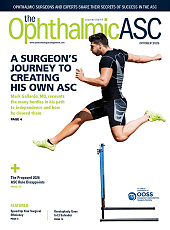A prospective study demonstrates that functional testing using electroretinography (ERG) combined with pupillometry outperforms traditional structural imaging methods in identifying patients with diabetic retinopathy (DR) at highest risk of progression to vision-threatening complications (VTC) over 1 year.
The findings, published online in Ophthalmology Science and scheduled to appear in the journal’s November/December print issue, come from a post hoc analysis of a multicenter US trial (TIME-2b; Aerpio Pharmaceuticals) evaluating the predictive power of 56 parameters derived from 4 testing modalities. These included ERG/pupillometry performed with a handheld RETeval device (LKC Technologies), ultrawidefield fluorescein angiography (UWF-FA), optical coherence tomography angiography (OCTA), and fundus photography (FP).
The study enrolled 162 participants diagnosed with moderate-to-severe nonproliferative diabetic retinopathy (NPDR) and without center-involved diabetic macular edema (DME) at baseline. The average age of the cohort was 57 years, and 58% were male. The study was conducted by a collaborative group including researchers affiliated with LKC Technologies. The authors disclosed affiliations with LKC Technologies and relevant consulting relationships.
In the 48-week longitudinal trial, several measures strongly predicted progression of DR to VTC, such as proliferative diabetic retinopathy (PDR) or DME. The most powerful predictor was the RETeval device’s DR score, which combines ERG and pupil response data. Patients with a RETeval DR score of ≥26.9 had a 5.6x higher risk of progression. Flicker ERG timing also had high prognostic value; for example, a 16 Td·s fundamental flicker time ≥34.6 ms was linked to a 4.6x higher risk. On OCTA, a foveal avascular zone (FAZ) area of ≥0.285 mm² carried a 3.8x higher risk, while smaller FAZ areas corresponded to only a 10% chance of progression. UWF-FA ischemia indices were also strong predictors, with a total ischemia index ≥0.125 yielding a 5.3x higher risk. Increased macular microaneurysm (MA) burden was associated with a 2.8x higher risk, and a Diabetic Retinopathy Severity Scale (DRSS) score ≥47 on FP was linked to a 2.1x higher risk.
“This research suggests that the ERG provides value in defining how DR is staged and monitored, supporting mounting evidence that functional changes in the retina can precede observable vascular abnormalities,” Mitchell Brigell, PhD, one of the study authors, said in a press release. “The findings clearly show the value of integrating objective functional testing into the management of diabetic retinopathy. This is also reflected in the inclusion of ERG in the American Academy of Opthalmology’s Preferred Practice Pattern Guidelines for Diabetic Retinopathy.”
The authors noted that although structural imaging remains valuable, functional testing captures early retinal dysfunction that may not yet be visible on imaging modalities. This finding supports integrating objective functional assessments into routine DR management to enhance risk stratification and personalize follow-up intervals, they concluded.
Limitations acknowledged by the study authors include the relatively small sample size of the prospective cohort and the need for further validation in larger, diverse populations. The researchers recommended additional multicenter studies to confirm these findings and explore the integration of ERG-based models into clinical workflows. RP








